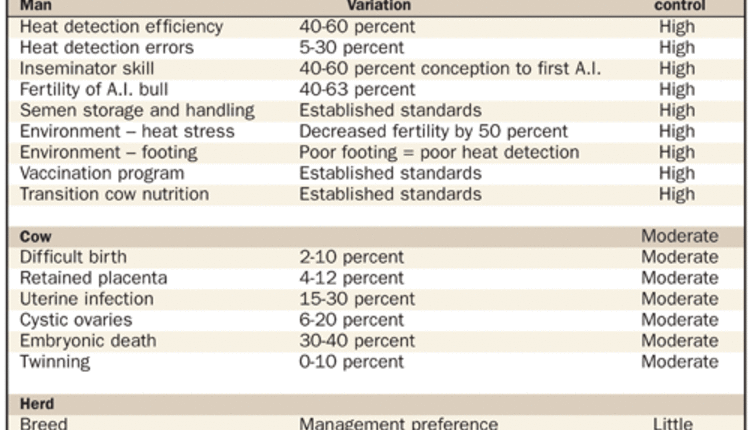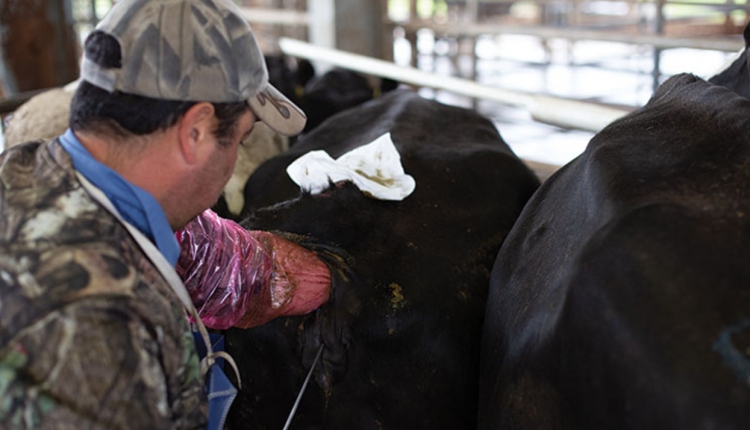The author is professor of animal sciences at Kansas State University, Manhattan.
I have had the privilege to visit a number of dairy farms during my lifetime. Without a doubt, dairy farmers are friendly and interested in learning new concepts. During my travels, I have benefitted greatly from my discussions with them and learned a great deal.
Many management styles exist. Every dairy producer has a different way to approach problems. Some may be more organized or more methodic, but none is lazy. Regardless of the approach, attacking the right nails with the right hammer is key to success.
Fertility factors
Many factors affect fertility in high-producing cows. Which ones are really important?
I refer you to an excellent thought-provoking review (The Professional Animal Scientist, 17:129-138) by Phil Senger, my predecessor in writing this column. Senger identified three major categories of factors affecting fertility (see table).

Because of obvious economic incentives, farm teams always focus on maximizing milk yield. These incentives far outweigh the incentives for reproduction. For example, tweaking the nutrition program can enhance or reduce milk yield almost immediately. In contrast, changing the heat detection program or the timed A.I. program (increasing compliance for example) can take weeks or months to determine its effect on pregnancy outcomes. The financial gains with improved fertility are difficult to measure because they represent lost opportunities for greater income and are not direct "out-of-pocket" expenses.
Paying attention to some of the following bottlenecks and resolving them should be the major focus of reproductive management teams. Some of Phil Senger's "Food for Thought" follows:
Many of the moderately controlled factors affecting fertility are related to disease and calving time problems. This should be the major focus of your management team that is led by your herd's veterinary practitioner. Education of those assisting calving cows is one area that is often overlooked. Understanding when and how to assist a calving heifer or cow is critical to her postpartum recovery and transition to lactation.
In the end, you will make the most progress by placing focus on solving problems over which you have major control and influence. Most of those bottlenecks are identified previously where you have a high degree of control. Prioritize your focus and greater success will follow.
Click here to return to the Reproduction E-Sources 1011_770
I have had the privilege to visit a number of dairy farms during my lifetime. Without a doubt, dairy farmers are friendly and interested in learning new concepts. During my travels, I have benefitted greatly from my discussions with them and learned a great deal.
Many management styles exist. Every dairy producer has a different way to approach problems. Some may be more organized or more methodic, but none is lazy. Regardless of the approach, attacking the right nails with the right hammer is key to success.
Fertility factors
Many factors affect fertility in high-producing cows. Which ones are really important?
I refer you to an excellent thought-provoking review (The Professional Animal Scientist, 17:129-138) by Phil Senger, my predecessor in writing this column. Senger identified three major categories of factors affecting fertility (see table).

- Some factors can be affected greatly by management (the management team can exert a major controlling influence).
- Other factors are inherent to the cow's reproductive tract where management has only moderate control.
- Lastly, some factors are inherent to the herd and almost beyond management control (little control).
Because of obvious economic incentives, farm teams always focus on maximizing milk yield. These incentives far outweigh the incentives for reproduction. For example, tweaking the nutrition program can enhance or reduce milk yield almost immediately. In contrast, changing the heat detection program or the timed A.I. program (increasing compliance for example) can take weeks or months to determine its effect on pregnancy outcomes. The financial gains with improved fertility are difficult to measure because they represent lost opportunities for greater income and are not direct "out-of-pocket" expenses.
Paying attention to some of the following bottlenecks and resolving them should be the major focus of reproductive management teams. Some of Phil Senger's "Food for Thought" follows:
- Heat detection is often performed "on the fly." Everybody thought somebody was responsible but nobody did it. The problem is associated with few cows showing strong heat signs because of poor footing or crowded or inadequate space for cow-to-cow interaction. One study reported that a 1 percent gain in heat detection efficiency resulted in 0.5-day drop in days open. That means, a 20 percent improvement would reduce days open by 10 days.
- More heat detection errors occur when only nonstanding secondary signs of heat are observed (such as tail chalk removal) and poor cow identification (identifying the wrong cow). When financial incentives are paid to workers for identifying cows in heat, more nonestrus cows will likely be submitted for A.I. breeding.
- Do not assume that anybody can A.I. breed cows with a high degree of success. Good A.I. technique requires deposition of semen in the uterine body. Comparing professional technicians with herdsman-inseminators demonstrated that using radiographic evaluation of insemination attempts resulted in only 39 percent of insemination pipette placement attempts in the uterine body, 25 percent in the cervix, and 36 percent in one uterine horn. Professional technicians had similar error rates to herdsman-inseminators. The most skilled inseminators achieved 63 percent conception to first service and the least skilled inseminator achieved only 41 percent. The within-herd variation ranged from 7 to 10 percent among inseminators.
- Warm water (95ºF for 30 to 60 seconds) thawing of frozen semen packaged in French straws is most appropriate and documented by 20 years of research. Prevention of post-thaw cold shock should be accomplished by prewarming the inseminating gun and using gun warmers or placing the loaded inseminating syringe inside the outer garment. Regular checking of liquid nitrogen refrigerators for leaks or frosting should be a routine chore.
- Heat stress increases early embryonic death (first few days after A.I. breeding), reduces the duration of heat, and decreases all heat activity of the cow. Using shade, ventilation, and sprinklers are mandatory to prevent losses of milk during summer but also can prevent some fertility loss.
- Cows show better heat activity on dirt surfaces. They prefer to show heat activity on dirt compared with a grooved-concrete surface. They will show heat longer (14 versus 9 hours), display more standing events (6 versus 3), and more mounts (7 versus 3) on dirt surfaces than on concrete.
Many of the moderately controlled factors affecting fertility are related to disease and calving time problems. This should be the major focus of your management team that is led by your herd's veterinary practitioner. Education of those assisting calving cows is one area that is often overlooked. Understanding when and how to assist a calving heifer or cow is critical to her postpartum recovery and transition to lactation.
In the end, you will make the most progress by placing focus on solving problems over which you have major control and influence. Most of those bottlenecks are identified previously where you have a high degree of control. Prioritize your focus and greater success will follow.










